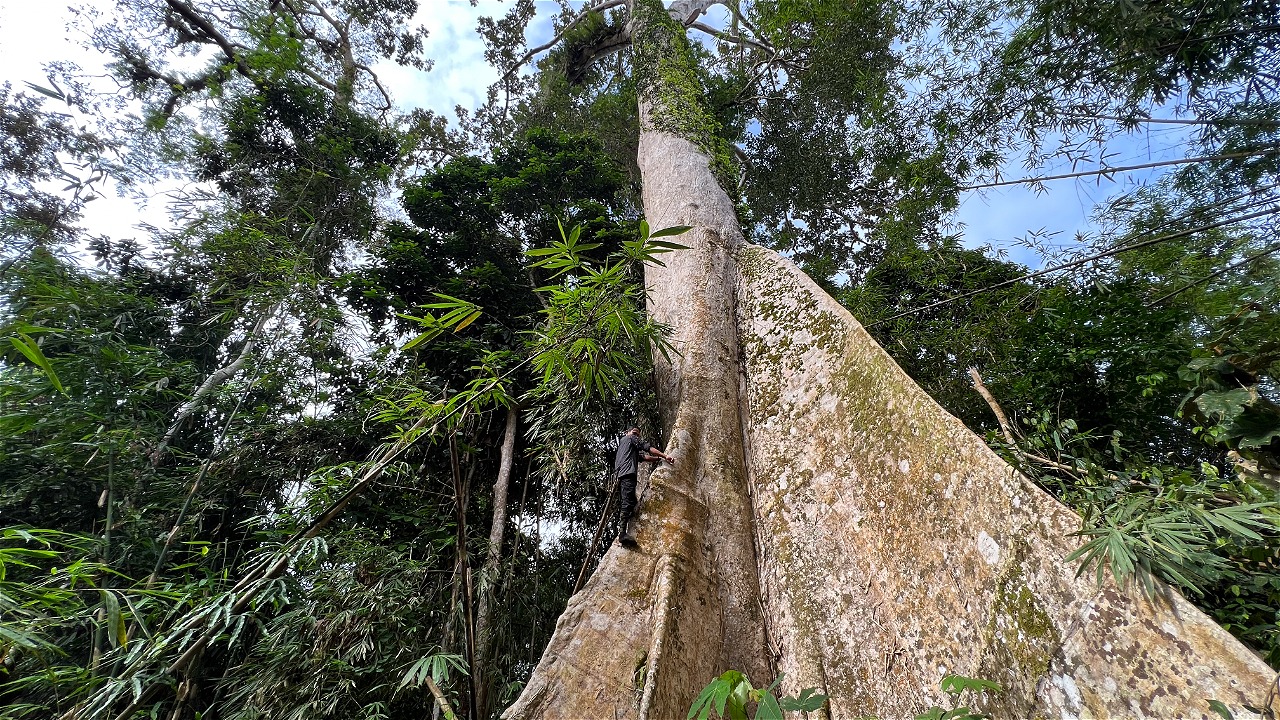SIALANG TREE: SORRY, NO HONEY THIS TIME
By: Diah R. Sulistiowati
About twenty people gathered under a big and tall tree, mostly teenagers and men, there were no mothers in the group. The men were busy discussing while smoking cigarettes and preparing equipment, while the teenagers were busy joking around while glancing at our group from Jakarta. Some of them were busy playing ludo through electronic devices, even though there is no signal in their village, but many of them have electronic devices.< br />
They were curious, because we were speaking in a foreign language, Yes! Because four of the seven of us were white, they were people from WWF Networks who were visiting Bukit Tiga Puluh to see ecosystem restoration activities in Bukit Tiga Puluh, Samerantihan Village, Jambi Province.
Interestingly, some of them dared to "test their guts" trying to talk to these foreigners, while shaking hands and saying "My Name is..." then ran away blushing embarrassed by other friends, and this was done in turn, quite boisterous and fun atmosphere under this tree, even though we were in a tropical forest and among healthy trees in the Bukit Tiga Puluh ecosystem restoration forest managed by PT Alam Bukit TIgapuluh (ABT).
When viewed from below, this Sialang Tree looks like its branches are plastered with something black with holes. If approached you can hear a buzzing sound, yes! it is a beehive attached to the high branches of the Sialang Tree, a tall tree that is usually a "home" for forest bee hives. Sialang Tree or Koompassia excels is a type of plant that is included in the Johar-joharan tribe, and can usually reach a height of more than 88 meters, at the bottom of this tree is wide and tall.
The people gathered below are the Talang Mamak tribe who want to harvest forest honey. This tree is one of the alternative incomes of indigenous peoples, one of which is the Talang Mamak tribe, which is carried out sustainably. The collection process is also carried out sustainably, by paying attention to the behavior of the bees, this is done so that the bees return to nest and produce honey, so they don't want to scare these bees.
The process of taking this bee honey is done quite creepy, yes! For us to imagine climbing this tall tree with simple equipment and without safety makes us shudder, even these colleagues from the WWF Network show confused and amazed faces, because naturally, there is no history in their heads about this dangerous work so they have difficulty imagining it.
According to Sudirman, a Talang Mamak tribesman, this was done to prevent bee stings, "Like humans, during the day the majority are active, at night only a few are active, so are bees". Sudirman and his team then prepare lantak, lantak is a footrest that will be stuck into the tree to hold the climbing foot. Usually, 40 lantaks can be used up for one tree. Other equipment includes tungkul or honey containers and tunam. Tunam is a tree root that is dried like the shape of a broomstick, later it will be burned and emit smoke, the smoke is what is used to repel bees.< br />
Before climbing and sticking the lantah into the tree, prayers are made to be given safety in the process of climbing the tree. "In our belief, there is a tree prophet who lives in the tree, so we ask permission not to get angry," Sudirman said again. After praying, one by one, the lantah is stuck into the tree, hit with a hammer and made sure the lantah is firmly stuck so that it can withstand the body. Slowly but surely, they climbed equipped with makeshift lighting, even according to them at the top it was quite bright.
No Honey Today
The process of collecting honey took quite a long time, it was already 11 pm but the process of climbing while hitting the lantah was not finished, because we had not eaten dinner and did not bring lunch, we said goodbye first. The next day we got the news that they did not succeed in getting honey, these foreigners immediately looked at us confused, demanding further explanation, they were very confused about the dangerous work that had been done but there was no result.
According to Sudirman's story, usually there are 100-150 hives attached to one tree, producing about 100-150 kilos of honey, but this time they only saw seven hives, so no honey was obtained. Why did this happen? According to Sudirman, this time the Sialang tree is often climbed by people from outside (other than the Talang Mamak tribe), "They climb during the day" explained Sudirman. Trees that are climbed during the day cause bees to be reluctant to stop by again, even Sudirman's story, people who often "steal" honey during the day often have accidents, because they are not used to climbing tall trees.< br />
There needs to be a guard
For this reason, with the forest restoration management managed by PT Alam Bukit Tiga Puluh, it is hoped that in the future this will not happen again. There must be strict guarding of the area so that the Sialang tree returns to produce honey, for the welfare of the Talang Mamak tribe who live in the Bukit Tigapuluh Ecosystem Restoration area. There is already a honey sales scheme by PT ABT, which will buy from the Talang Mamak community, package and market it at a fair price.





